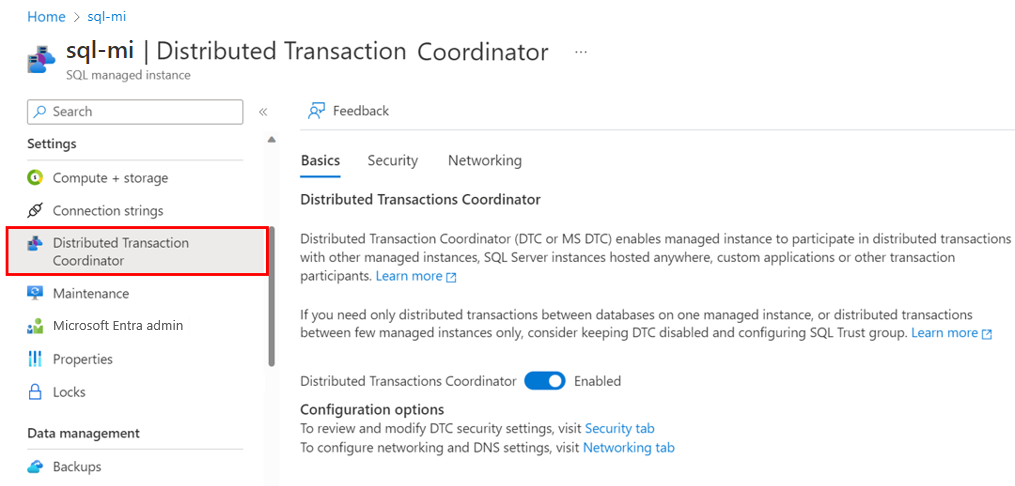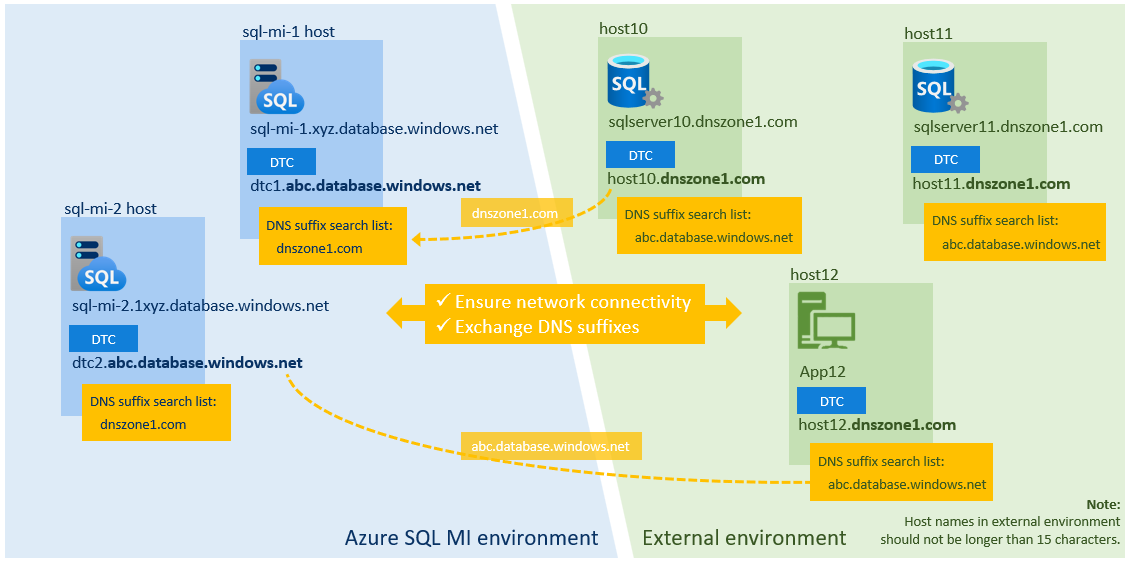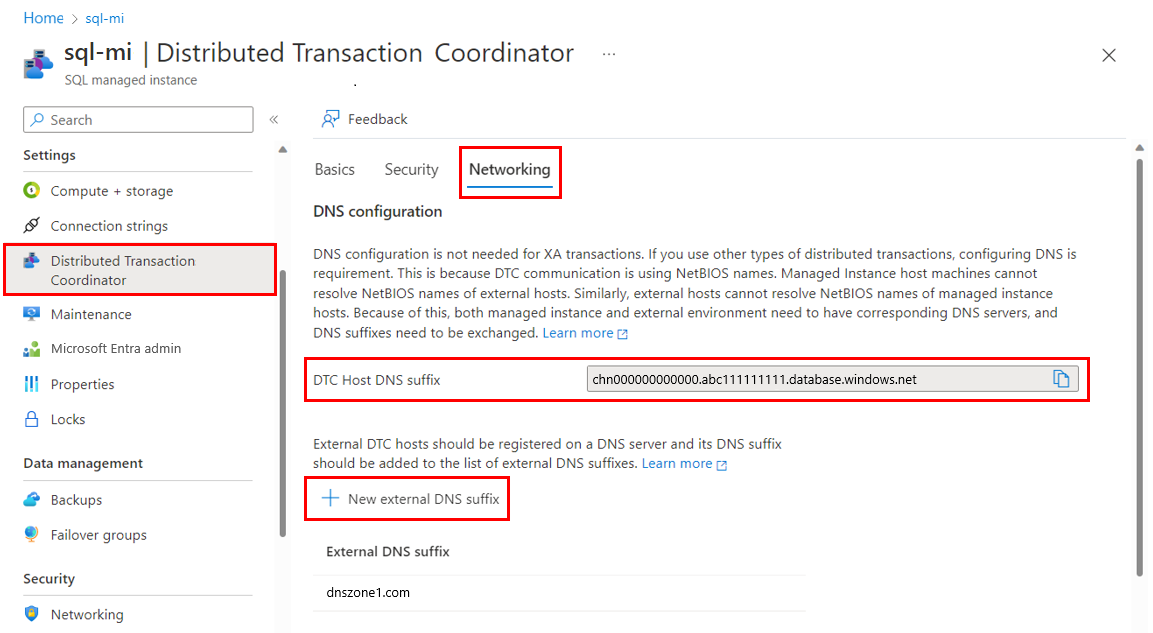Distributed Transaction Coordinator (DTC) for Azure SQL Managed Instance
Applies to:
Azure SQL Managed Instance
This article provides an overview of Distributed Transaction Coordinator (DTC) for Azure SQL Managed Instance. You can use DTC to run distributed transactions in mixed environments, including across managed instances, SQL Server instances, other relational database management systems (RDBMSs), custom applications, and other transaction participants that are hosted in any environment that can establish network connectivity to Azure.
Scenarios
You can enable DTC for Azure SQL Managed Instance to run distributed transactions across multiple environments that can establish network connectivity to Azure. DTC for SQL Managed Instance is managed, which means that Azure takes care of management and maintenance, like logging, storage, DTC availability, and networking. Aside from the managed aspect, DTC for SQL Managed Instance is the same DTC Windows service that supports traditional distributed transactions for SQL Server.
DTC for SQL Managed Instance unlocks a wide range of technologies and scenarios, including XA, .NET, T-SQL, COM+, ODBC, and JDBC.
To run distributed transactions, complete these tasks:
- Configure DTC.
- Enable network connectivity between participants.
- Configure DNS settings.
Note
For T-SQL or .NET distributed transactions across databases that are hosted only by managed instances, we recommend that you use native support for distributed transactions.
Requirements
To change DTC settings, you must have write permissions for Microsoft.Sql/managedInstances/dtc resource. To view DTC settings, you must have read permissions for Microsoft.Sql/managedInstances/dtc resource.
Configure DTC
You can configure DTC with Azure portal, Azure PowerShell and CLI.
To configure DTC by using the Azure portal:
In the Azure portal, go to your managed instance.
In the left menu under Settings, select Distributed Transaction Coordinator.

On the Basics tab, set Distributed Transaction Coordinator to Enabled.
On the Security tab, allow inbound or outbound transactions, and enable XA or SNA LU.
On the Networking tab, specify DTC DNS, and get information to configure external DNS and networking.
Network connectivity
To use DTC, all transaction participants must have a network connection to Azure. Because managed instances are always deployed to a dedicated virtual network in Azure, you must connect your external environment to the virtual network of your managed instance. In this context, external refers to any object or process that isn't your managed instance. If your external resource also uses a virtual network in Azure, you can use virtual network peering. Otherwise, establish connectivity by using your preferred method, such as point-to-site VPN, Azure ExpressRoute, or another network connectivity technology that meets your business needs.
Port 135 must allow both inbound and outbound communication, port range 14000-15000 must allow inbound, and 49152-65535 must allow outbound communication, in both the virtual network network security group for the managed instance and in any firewall that's set up in the external environment.
DNS settings
DTC relies on a transaction participant's NetBIOS name for mutual communication. Because the NetBIOS protocol isn't supported by Azure networking and NetBIOS names can't be resolved in mixed environments, DTC for a managed instance relies on DNS name servers for host name resolution. Managed instance DTC hosts are automatically registered with the Azure DNS server. You must register external DTC hosts with a DNS server. The managed instance and external environment also must exchange DNS suffixes.
The following diagram shows name resolution across mixed environments:

Note
You don't need to configure DNS settings if you plan to use DTC only for XA transactions.
To exchange DNS suffixes:
In the Azure portal, go to your managed instance.
In the left menu under Settings, select Distributed Transaction Coordinator. Select the Networking tab.

In DNS configuration, select New external DNS suffix. Enter the DNS suffix for your external environment, such as
dnszone1.com.Copy the value for DTC Host DNS suffix. Then use the PowerShell command
Set-DnsClientGlobalSetting -SuffixSearchList $liston your external environment to set the DTC Host DNS suffix. For example, if your suffix isabc1111111.database.windows.net, define your$listparameter to get the existing DNS settings. Then, append your suffix to it as shown in the following example:$list = (Get-DnsClientGlobalSetting).SuffixSearchList + "abc1111111.database.windows.net" Set-DnsClientGlobalSetting -SuffixSearchList $list
Test network connectivity
After you configure networking and DNS, run Test-NetConnection (TNC) between the DTC endpoints of your managed instance and the external DTC host.
To test the connection, first update the user-configurable values. Then, use the following PowerShell script on the external environment to identify the fully qualified domain name (FQDN) of the DTC host managed instance. Here's an example:
# ===============================================================
# Get DTC settings
# ===============================================================
# User-configurable values
#
$SubscriptionId = "a1a1a1a1-8372-1d28-a111-1a2a31a1a1a1"
$RgName = "my-resource-group"
$MIName = "my-instance-name"
# ===============================================================
#
$startMoveUri = "https://management.azure.com/subscriptions/" + $SubscriptionId + "/resourceGroups/" + $RgName + "/providers/Microsoft.Sql/managedInstances/" + $MIName + "/dtc/current?api-version=2022-05-01-preview"
Write-Host "Sign in to Azure subscription $SubscriptionID ..."
Select-AzSubscription -SubscriptionName $SubscriptionID
$azContext = Get-AzContext
$azProfile = [Microsoft.Azure.Commands.Common.Authentication.Abstractions.AzureRmProfileProvider]::Instance.Profile
$profileClient = New-Object -TypeName Microsoft.Azure.Commands.ResourceManager.Common.RMProfileClient -ArgumentList ($azProfile)
Write-Host "Getting authentication token for REST API call ..."
$token = $profileClient.AcquireAccessToken($azContext.Subscription.TenantId)
$authHeader = @{'Content-Type'='application/json';'Authorization'='Bearer ' + $token.AccessToken}
# Invoke API call to start the operation
#
Write-Host "Starting API call..."
$startMoveResp = Invoke-WebRequest -Method Get -Headers $authHeader -Uri $startMoveUri
Write-Host "Response:" $startMoveResp
# End
# ===============================================================
The JSON output looks like the following example FQDN:
chn000000000000.zcn111111111.database.windows.net
Where:
chn000000000000is the NetBIOS name of the managed instance DTC host.zcn111111111.database.windows.netis the DNS suffix.
Next, run a TNC to both the FQDN and the NetBIOS name of the managed instance DTC host on port 135. In the following example, the first entry verifies network connectivity. The second entry verifies that the DNS settings are correct.
tnc chn000000000000.zcn111111111.database.windows.net -Port 135
tnc chn000000000000 -Port 135
If connectivity and DNS suffixes are configured correctly, the output TcpTestSucceeded : True appears.
On the managed instance side, create a SQL Agent job to run the TNC PowerShell command to test connectivity to your external host.
For example, if the FQDN for your external host is host10.dnszone1.com, run the following test via your SQL Agent job:
tnc host10.dnszone1.com -Port 135
tnc host10 -Port 135
Limitations
Consider the following limitations when you use DTC with SQL Managed Instance:
- Running distributed T-SQL transactions between SQL Managed Instance and a third-party RDBMS isn't supported. SQL Managed Instance doesn't support linked servers that have third-party RDBMSs. Conversely, running distributed T-SQL transactions between managed instances and SQL Server and other SQL Server-based products is supported.
- Host names in external environment can't be longer than 15 characters.
- Distributed transactions to Azure SQL Database aren't supported with DTC.
- For authentication, DTC supports only the no authentication option. Mutual authentication and incoming caller authentication options aren't available. Because DTC exchanges only synchronization messages and not user data, and because it communicates solely with the virtual network, this limitation isn't a security risk.
Manage transactions
To view statistics of distributed transactions, see sys.dm_tran_distributed_transaction_stats.
You can reset the DTC log with the sp_reset_dtc_log stored procedure.
Distributed transactions can be managed with the sys.sp_manage_distributed_transaction stored procedure.
Next steps
For native managed instance distributed transaction support, see Elastic transactions.